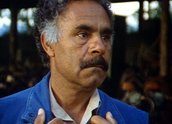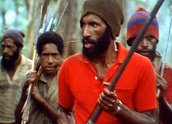


Black Harvest (1992)
Synopsis
By late 1989, filmmakers Robin Anderson and Bob Connolly were ready to go back to the PNG highlands to make the third film in the Highlands Trilogy, Black Harvest. This film follows First Contact (1983) and Joe Leahy’s Neighbours (1988) and continues to explore the relationship between Joe, who is now a ‘tribal leader’, and his Ganiga neighbours. Kaugum, the coffee plantation Joe Leahy owns jointly with the Ganiga, is coming on stream and all Joe’s promises of wealth for the Ganiga should be coming to fruition. Then the price of coffee suddenly plunges internationally which means that the Ganiga will have to work on the plantation for low wages. And at the same time, tribal warfare erupts which keeps the Ganiga away from the plantation. What could have been a golden opportunity unravels in a spectacular way. It is an epic struggle between PNG tribal culture and Western capitalism. Black Harvest is shot in an observational style with some narration, interviews and footage from First Contact (1983) and Joe Leahy’s Neighbours (1988).
Curator’s notes
When they finished shooting Joe Leahy’s Neighbours (1988) in 1987, Anderson and Connolly had planned to return when the joint venture between Joe Leahy and the Ganiga’s 300-acre coffee plantation, Kaugum, was ripe for the pickings and Joe’s promises of riches would start eventuating. Coffee was one of the most lucrative crops in the world and Joe had become a millionaire from Kilima, his first coffee plantation on land he bought from the Ganiga. Kaugum’s overheads were relatively small and the Ganiga were going to come into a massive amount of wealth. The filmmakers were interested in what was going to happen – how that wealth was going to be distributed and what the people would do with it.
When coffee prices internationally plunged the filmmakers had to change their ideas for the film altogether, responding to events as they unfolded. The story strands weave seamlessly together while the frustration and tension build to an almighty crescendo of hopes and dreams splitting asunder.
Bob Connolly states in an interview on the DVD, ‘We were witness to a Greek tragedy of quite extraordinary dimensions. On top of a sense of trepidation, there is what I would like to call a fearful elation. There is a sense as a professional, as an observer, that you are witness to quite a profound series of human events. Perhaps it is a small stage involving these people in an insignificant part of the world but, nevertheless, we were witnesses to an extraordinary tragedy’.
Black Harvest won many awards, including the 1992 Australian Film Institute, Australian Film Critics Circle and Sydney Film Festival Awards for Best Documentary; Festival Cinéma du Réel in Paris, the Grand Prix; Society for Visual Anthropology Award of Excellence; Royal Anthropological Institute, Basil Wright Prize for Best Documentary; Earthwatch Award; Festival d’Aurillac, Grand Prix; Hawaiian, Vancouver and San Francisco Film Festival Awards for Best Documentary; Los Angeles Association of Film Critics prize for Best Documentary; and the Yamagata International Documentary Festival, Robert Flaherty Grand Prize.
Bob Connolly also wrote a riveting and surprisingly honest account of their experiences while shooting this film. The book is called Making ‘Black Harvest’ – Warfare, Filmmaking and Living Dangerously in the Highlands of Papua New Guinea (2005, ABC Books). It won the 2005 Walkley Award for a non-fiction book.
Black Harvest screened in many film festivals around the world before it was broadcast in Australia on the ABC in 1992 and in other countries including the US, Canada, UK, France, Germany, Switzerland, Italy and Japan.
- Overview
- Curator’s notes
- Video 3 clips

- Principal credits
- Find a copy
- Make a comment
- Add your review



